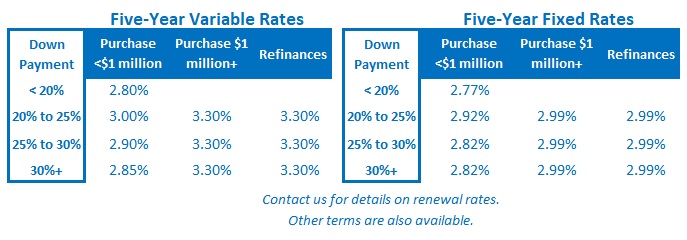Five Inflation Highlights with Implications for Canadian Mortgage Rates
May 21, 2019What Our Inverted Yield Curve Means for Canadian Mortgage Rates
June 10, 2019 The Bank of Canada (BoC) left its policy rate unchanged when it met last week, as expected.
The Bank of Canada (BoC) left its policy rate unchanged when it met last week, as expected.
In its accompanying statement, the Bank offered its latest take on the incoming data with specific emphasis on “developments in household spending, oil markets, and the global trade environment”.
In today’s post I’ll break down the BoC’s observations and offer my take on how these three key areas are evolving.
First, some background.
At its April meeting the Bank acknowledged that our economic momentum had slowed unexpectedly but forecast that it would recover in the second half of 2019. The underlying message in that prediction was that the BoC’s next move would still be a hike, and that our current economic soft patch would only delay it.
Interestingly, bond-market investors didn’t buy that view. (And as strange as it might sound, the bond market actually has a much better track record of predicting the BoC’s next move than the Bank itself does.) The bond market continues to bet that the BoC’s next move will be a cut.
With those opposing views in mind, I will juxtapose the Bank’s latest observations with what the bond market might be seeing instead.
Household Spending
Household spending refers to the items that Canadians buy to meet their everyday needs.
Our economy has been propped up by a steady increase in household spending since the Great Recession, but this rise has been underpinned primarily by increases in debt rather than by rising incomes.
The BoC is rightly concerned about the impact that its five recent quarter-point rate increases will have on future consumer spending because high debt levels make it more difficult for Canadian consumers to absorb rate hikes. Also, much of the impact from each hike occurs with a lag, and by the Bank’s own estimate, it will take until October 2020 before the full impact of its recent tightening cycle can be comprehensively assessed.
In its most recent statement, the BoC observed that “recent data support a pick-up in consumer spending”. To wit, last Friday Statistics Canada confirmed that household spending rose by 3.5% on an annualized basis in the first quarter of this year. The Bank also noted that we are experiencing “strong job growth”, which would typically portend rising incomes that would lead to increased consumer spending in the future.
While the first-quarter uptick in consumer spending was positive news overall, here are some of the concerns that may be tempering the bond market’s enthusiasm:
- As cited above, the BoC’s previous rate hikes have yet to reach their full impact, and elevated debt levels have made Canadians more responsive to rate hikes. There is concern that the Bank may have overtightened, and that is feeding into the belief that the BoC’s next move may be a cut.
- Our first-quarter increase in consumer spending corresponded with a household saving rate of only 1.1%, well below our average of about 4% over the past several years, and further still below our average of about 7% over the past forty years. At these spending levels, the average Canadian isn’t building much of a buffer for leaner times.
- Our recent strong job-growth number centred around some pretty wonky stats. Although our economy created an estimated 106,500 new jobs in April, the bulk of that growth skewed disproportionately toward workers aged 15 to 24 whose incomes aren’t going to drive household spending significantly higher. And while it’s true that job growth has been strong, average incomes are still barely keeping pace with inflation. (Average weekly earnings rose 1.9% year over year in March and our overall inflation rate stood at 1.9% in April.)
- The BoC noted that “inventories rose sharply in the first quarter”. Given that, even if the recent pickup in household spending continues, it is unlikely to stoke inflationary pressures until our economy’s recent inventory buildup is depleted.
Oil Markets
The BoC continues to closely monitor the recovery in Alberta’s oil patch, which remains hampered by transportation bottlenecks that are greatly limiting our oil exporters’ ability to access foreign markets other than the U.S.
In its most recent statement, the Bank assessed that “the oil sector is beginning to recover as production increases and prices remain above recent lows”.
While the BoC’s assessment can be characterized as cautiously optimistic, bond-market investors might hold a less enthusiastic view based on the following factors:
- Canadian oil prices have recovered from their recent lows but only due to the production quotas imposed by the Alberta government. According to the CEO of Husky Energy Inc., Ron Peabody, those same quotas have “come at the cost of service industry layoffs, poorer rail shipping economics and unprecedented uncertainty among investors”.
- Alberta’s oil quota presently keeps about 325,000 barrels of Canadian oil off the market, but that number is scheduled to fall to 175,000 barrels this month. There is uncertainty about how the reduced restriction will impact the price gap between a barrel of Western Canadian Select and a barrel of West Texas Intermediate.
- On its first day in office, Alberta’s newly elected United Conservative Party introduced new “turn off the taps” legislation that could cut off shipments of oil and refined products to British Columbia if its government continues to block Alberta’s pipeline expansion efforts. This escalation in brinkmanship further heightens uncertainty in our already beleaguered oil sector and reduces the likelihood of any near-term turnaround in investment in the sector.
The Global Trade Environment
The BoC assessed that “the recent escalation of trade conflicts is heightening uncertainty about economic prospects”.
The Bank also observed that “trade restrictions introduced by China are having direct effects on Canadian exports” while “the removal of [U.S.] steel and aluminum tariffs and increasing prospects for ratification of CUSMA will have positive implications for Canadian exports and investment”.
Further to that last point, the BoC noted that “business investment has firmed” and that recent data support a pickup in exports in the second quarter.
Here is where the bond market may look at the trade file differently:
- The ratification of the new Canada/U.S./Mexico Agreement (CUSMA) that will replace the North American Free Trade Agreement (NAFTA) is far from certain, and it may well become a political football in the ongoing feud between the democratic led U.S. House of Representatives and U.S. President Donald Trump. Speaker Nancy Pelosi has expressed concern about the impact that the deal will have on American workers, and Trump is threatening to pull out of NAFTA in the meantime to force Pelosi’s hand. The recent removal of the U.S. steel and aluminum tariffs was an encouraging development, but that didn’t require the kind of cooperation that ratifying CUSMA will. Trump’s recent threats to impose a 5% tariff on all goods imported from Mexico (and rising to 25% in October) until it stops migrants from crossing into the U.S. illegally could also derail CUSMA’s passage.
- China is a top buyer for most Canadian farm commodities, and it has recently blocked imports of Canadian soybeans, peas and pork for what are widely believed to be politically motivated reasons. China’s actions are in retaliation for the arrest of Huawei chief financial officer Meng Wanzhou and are designed to ratchet up pressure in advance of the hearing to decide if she will be extradited to the U.S. This ongoing conflict heightens uncertainty for any and all Canadian firms who export to China.
- The U.S./China tariff war continues to escalate. In the latest salvo, the U.S. increased tariffs 10% to 25% on $200 billion USD worth of Chinese imports in May. China has responded with retaliatory tariffs and a reduction in its purchases of U.S. products, particularly soybeans, which are one of the most valuable U.S. export crops. China is the dominant provider of rare earth metals that are essential ingredients in the production of many high-tech products, and in the latest round of sabre rattling, it is also threatening to restrict supplies to U.S. manufacturers. The most direct impacts of these measures are being felt by the U.S and China, but the locking of horns between the world’s two largest economies has also created knock-on effects that are reverberating across the global with increasing magnitude.
- While our recent export and business investment data have shown improvement, it is hard to be optimistic that both trends will continue against the current trade backdrop.
Finally, Canadian bond-market investors will have noted that the U.S. futures market is now assigning 55% odds that the U.S. federal reserve will cut rates at its next meeting on July 31 and 78% odds that it will have cut rates at least once by its following meeting on September 18.
While much of the recent Canadian economic data has been more encouraging than the comparable U.S. data, if the Fed cuts its policy rate, bond-market investors may expect that the BoC will have no choice but to follow suit. Failure to do so would buoy the already stubbornly lofty Loonie and further undermine the current momentum in our export sector, which is underpinning the Bank’s optimism.
Bluntly put, the BoC’s outlook comes with a healthy dose of hope, and the bond market’s view comes with a healthy dose of scepticism. In the current environment, the latter seems a more reliable outlook than the former.

The Bottom Line: Last week the BoC reconfirmed its belief that our current slowdown will prove temporary. The bond market is less convinced, and that’s why Government of Canada bond yields continue to fall, as do the fixed mortgage rates that are priced on them. In addition, the futures market continues to bet that the BoC’s next move will be a cut and that our variable mortgage rates are more likely to fall than to rise.







